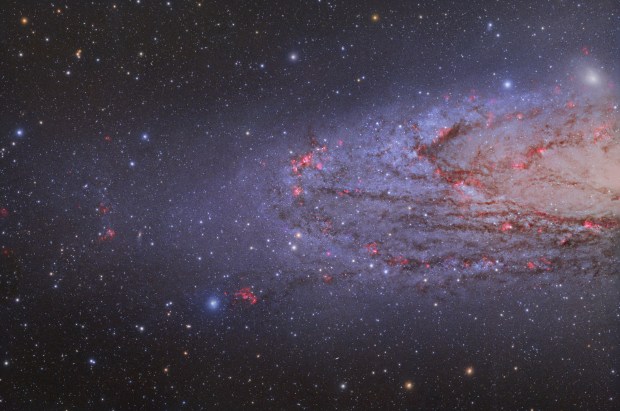The universe is incredibly vast, beyond what we can comprehend.
Humans have explored only a tiny portion of our own galaxy, amidst the vast number of galaxies in the universe.
Many individuals, including those with a keen interest in astronomy, often ponder the frequent accounts of UFOs or UAPs (unidentified anomalous phenomena) that are regularly observed in the sky, causing a frenzy of speculation about extraterrestrial visitations. However, those who genuinely harbor concerns about this matter have never undergone the initial week of an academic course on what astronomers refer to as the cosmic distance scale.

In the words of the renowned author Douglas Adams, who penned A Hitchhiker’s Guide to the Galaxy, “Space is vast. You simply cannot comprehend the immense, colossal, mind-boggling expanse it encompasses. I mean, you might assume that traveling to the local pharmacy is a considerable distance, but that is utterly insignificant compared to the enormity of space.”
Adams’ statement holds true. Let us commence by contemplating the realm of local space. For the sake of illustration, let’s imagine that the distance between Earth and the Sun, which is known as 1 astronomical unit, is merely 1 centimeter instead of its actual measurement of 93 million miles. It is worth noting that throughout the entirety of human history, we have physically traversed an infinitesimally minuscule fraction of that 1 centimeter.
Comparing cosmic distance scale
A scale model of the solar system can be visualized in various locations such as your room, neighborhood, and town. In this model, if we consider the distance between the Sun and Jupiter to be 5 cm, we can continue to imagine the relative distances as we move further away. Saturn would then be 10 cm from the Sun, Uranus 19 cm from the Sun, and Neptune 30 cm from the Sun. The dwarf planet Pluto, on the other hand, would typically be around 40 cm away from the Sun.
However, it’s important to note that on this scale, the physical diameter of the solar system is much larger. The outer edge of the Oort Cloud, which consists of approximately a trillion comets, would be located 10 football fields away. So far, our exploration has only covered a minuscule fraction of the original 1 cm distance.
And this is just within our solar system. The nearest star, Proxima Centauri, is four times farther away than the outer edge of the Oort Cloud. The vast gap between even the closest stars is truly immense. The actual distance to Proxima Centauri is 4.2 light-years, which means that it takes light, the fastest known entity, 4.2 years to travel from that star to reach our eyes.
Beyond the Milky Way
We have the ability to make significant advancements on a universal scale as well. The Milky Way Galaxy is just one of over 100 billion galaxies in the universe. The diameter of the bright disk of the Milky Way, where we are located, spans at least 100,000 light-years. (Our position is a little over 26,000 light-years away from the galaxy’s center.) The farthest photons from our galaxy have been traveling towards us for about one-third of the length of human history.
Similar to nesting dolls, we can trace cosmic structures to larger and larger scales. Our Local Group of galaxies, as named by Edwin Hubble in the 1930s, consists of at least 55 galaxies within a sphere covering approximately 10 million light-years. Among the members of the Local Group are our neighboring galaxies, the Andromeda Galaxy and the Triangulum Galaxy.
There are numerous smaller groups of galaxies even further away, and if we journey about 55 million light-years, we reach the core of the largest galaxy cluster in our cosmic vicinity, the Virgo Cluster. This cluster comprises around 1,300 galaxies of various kinds. However, there are much larger and more massive galaxy groups situated at even greater distances from us. Their numbers are nearly countless.
As we explore the largest known cosmic structures, we encounter superclusters and walls of galaxy clusters. One example is Laniakea, to which we belong, a structure that extends across approximately 500 million light-years. There are numerous other large structures as well.
The universe could, indeed, be infinite
The size of the universe remains a mystery. According to the current estimation, the diameter of the universe is at least 93 billion light-years. However, if cosmic inflation is indeed accurate, then the visible universe we observe might not encompass the entirety of it. It may seem like a concept from science fiction, but it is plausible that the universe is infinitely vast. Regardless of its size, we are aware that the universe is continuously expanding and this expansion is accelerating over time.
Fortunately, we are able to observe the distant universe as it existed in the past due to the massless nature of photons, which travel at the fastest speed possible, 186,000 miles per second. Those who are perplexed or distressed by reports of UFOs fail to comprehend the immense cosmic distances involved. They also fail to grasp that only massless objects like photons can achieve such high velocities. Objects with mass require an enormous amount of energy to attain high-speed motion. Still skeptical? Try consuming a tuna sandwich and running around the Earth’s circumference multiple times before taking a break. Then you will understand.
While the universe may potentially be teeming with life (a topic for another discussion), it is so remote that we will not come across it in our daily lives, such as having lunch together in Central Park. This is the harsh reality that trained astronomers are well aware of.
Do not forget to share your opinion with us to provide you with the best posts !



0 Comments